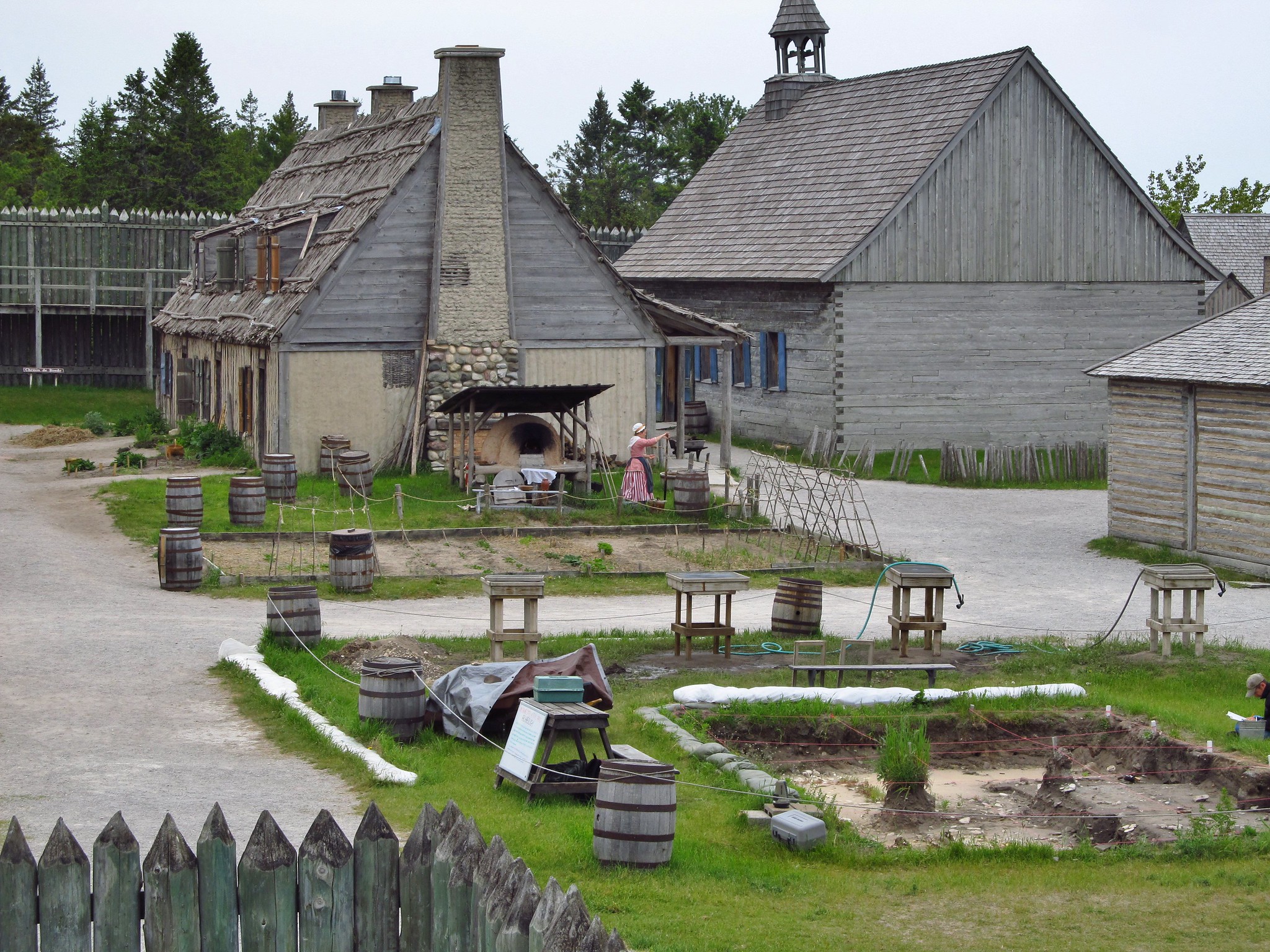Browse "Historic sites"
-
Article
Fort Michilimackinac
Fort Michilimackinac is located on the south side of the Straits of Mackinac. It sits on a sand beach in the northernmost extension of the Lower Peninsula of Michigan. Michilimackinac was the second fort to guard the Straits of Mackinac. The fort was a key trade, military, and diplomatic post for the French (1715–61) and the British (1761–81). The fort’s buildings were moved by the British in 1780-1 to a more defensible location on Mackinac Island. Fort Michilimackinac was reconstructed in the 20th century and serves as a living history museum in Michigan.
"https://d2ttikhf7xbzbs.cloudfront.net/Michilimackinac/Michilimackinac-State-Park-buildings.jpg" // resources/views/front/categories/view.blade.php
https://d2ttikhf7xbzbs.cloudfront.net/Michilimackinac/Michilimackinac-State-Park-buildings.jpg
-
Article
Fort Mississauga National Historic Site of Canada
Fort Mississauga National Historic Site, located in NIAGARA-ON-THE-LAKE, Ont, was designated as a national historic site in 1931 by the Historic Sites and Monuments Board of Canada. The British built Fort Mississauga between 1813 and 1823 to guard the mouth of the NIAGARA RIVER.
"https://development.thecanadianencyclopedia.ca/images/tce_placeholder.jpg?v=e9dca980c9bdb3aa11e832e7ea94f5d9" // resources/views/front/categories/view.blade.php
https://development.thecanadianencyclopedia.ca/images/tce_placeholder.jpg?v=e9dca980c9bdb3aa11e832e7ea94f5d9
-
Article
Fort Niagara
Throughout the American Revolution, Fort Niagara was the major British supply depot for the Loyalist provincial troops, Butler's Rangers, and Seneca allies who raided rebel supply lines.
"https://d2ttikhf7xbzbs.cloudfront.net/media/media/659c26df-741b-477d-8d28-b5a7c4212206.jpg" // resources/views/front/categories/view.blade.php
https://d2ttikhf7xbzbs.cloudfront.net/media/media/659c26df-741b-477d-8d28-b5a7c4212206.jpg
-
Article
Fort Pitt
Founded in 1830, Fort Pitt was the major Hudson's Bay Company trading post between Forts Edmonton and Carlton (Saskatchewan), located at a large bend in the North Saskatchewan River just east of the modern Alberta-Saskatchewan border.
"https://d2ttikhf7xbzbs.cloudfront.net/media/media/2a58e580-6da4-4fd4-b1fe-dc1357c14c36.jpg" // resources/views/front/categories/view.blade.php
https://d2ttikhf7xbzbs.cloudfront.net/media/media/2a58e580-6da4-4fd4-b1fe-dc1357c14c36.jpg
-
Article
Fort Reliance
Fort Reliance, YT, is an abandoned post, established in 1874, located on the east bank of the YUKON RIVER, 13 km downstream from DAWSON. It remained the centre of the FUR TRADE and mining on the upper Yukon River for more than a decade.
"https://development.thecanadianencyclopedia.ca/images/tce_placeholder.jpg?v=e9dca980c9bdb3aa11e832e7ea94f5d9" // resources/views/front/categories/view.blade.php
https://development.thecanadianencyclopedia.ca/images/tce_placeholder.jpg?v=e9dca980c9bdb3aa11e832e7ea94f5d9
-
Article
Fort Saint-Pierre
Fort Saint-Pierre is a French trading post spanning the years c. 1632 to 1669. It is situated on the southeastern shore of Cape Breton Island, in the village of St. Peters, on the Atlantic coast of a narrow isthmus separating the inland waterway of Lake Bras D'or from the open ocean.
"https://d2ttikhf7xbzbs.cloudfront.net/media/media/53e44654-9a96-4878-852f-9637b47db180.jpg" // resources/views/front/categories/view.blade.php
https://d2ttikhf7xbzbs.cloudfront.net/media/media/53e44654-9a96-4878-852f-9637b47db180.jpg
-
Article
Fort Selkirk
The trading post was short-lived; it shut down in the summer of its establishment after it was attacked and plundered by the Chilkat. In 1898-99 the site was the base of the YUKON FIELD FORCE. A private trading post was established by Arthur Harper around 1890.
"https://d2ttikhf7xbzbs.cloudfront.net/media/media/ed5cd90d-59e6-4f79-98c0-9d447f907a0b.jpg" // resources/views/front/categories/view.blade.php
https://d2ttikhf7xbzbs.cloudfront.net/media/media/ed5cd90d-59e6-4f79-98c0-9d447f907a0b.jpg
-
Article
Fort St Joseph National Historic Site of Canada
Fort St Joseph National Historic Site, near Sault Ste Marie, Ont, was designated by the Historic Sites and Monuments Board of Canada in 1923 to recognize Fort St Joseph's significance as the most westerly British post and for its importance to the fur trade and to the alliances with First Nations.
"https://development.thecanadianencyclopedia.ca/images/tce_placeholder.jpg?v=e9dca980c9bdb3aa11e832e7ea94f5d9" // resources/views/front/categories/view.blade.php
https://development.thecanadianencyclopedia.ca/images/tce_placeholder.jpg?v=e9dca980c9bdb3aa11e832e7ea94f5d9
-
Article
Fort Carillon (Ticonderoga)
Fort Carillon was built in 1755 on the orders of the governor of New France, Pierre de Rigaud de Vaudreuil. Situated at the junction of Lake George and Lake Champlain, the fort was intended to reinforce France's military presence in an area contested by the British colonies. In 1759, Fort Carillon was abandoned by the French and renamed Fort Ticonderoga by the British. (See Seven Years’ War.)
"https://d2ttikhf7xbzbs.cloudfront.net/Fort_Ticonderoga_Ticonderoga_NY.jpg" // resources/views/front/categories/view.blade.php
https://d2ttikhf7xbzbs.cloudfront.net/Fort_Ticonderoga_Ticonderoga_NY.jpg
-
Article
Fort Toulouse and Port Toulouse
The village of Port Toulouse and its fort are situated in St. Peter's, Cape Breton, Nova Scotia.
"https://d2ttikhf7xbzbs.cloudfront.net/media/media/02cde42e-b8fa-42bb-a0c6-fcbc67f53b8a.jpg" // resources/views/front/categories/view.blade.php
https://d2ttikhf7xbzbs.cloudfront.net/media/media/02cde42e-b8fa-42bb-a0c6-fcbc67f53b8a.jpg
-
Article
Fort Vancouver
Fort Vancouver, a HUDSON'S BAY CO fur-trade post, was originally constructed in 1825 by Dr. John McLoughlin about 150 km inland on the north bank of the Columbia River, 8 km above the mouth of the Willamette. In 1829, the
"https://d2ttikhf7xbzbs.cloudfront.net/media/media/8995b1e1-60ec-48e0-8b23-d944da85cc4d.jpg" // resources/views/front/categories/view.blade.php
https://d2ttikhf7xbzbs.cloudfront.net/media/media/8995b1e1-60ec-48e0-8b23-d944da85cc4d.jpg
-
Article
Fort Victoria
In 1842, James DOUGLAS of the HUDSON'S BAY CO selected the port of Camosack (the harbour where Victoria now stands) as a new fur-trade post - eventually to replace FORT VANCOUVER as the company's Pacific headquarters and to bolster the British claim to VANCOUVER ISLAND.
"https://development.thecanadianencyclopedia.ca/images/tce_placeholder.jpg?v=e9dca980c9bdb3aa11e832e7ea94f5d9" // resources/views/front/categories/view.blade.php
https://development.thecanadianencyclopedia.ca/images/tce_placeholder.jpg?v=e9dca980c9bdb3aa11e832e7ea94f5d9
-
Article
Fort Walsh
Following the defeat of General George Custer (1876), the Mounted Police centered at Fort Walsh were called upon to mediate with refugee Sioux who had followed Chief SITTING BULL across the US border, thereby creating an international incident.
"https://d2ttikhf7xbzbs.cloudfront.net/media/media/b7bd4098-56cd-4e5e-a735-7d8ef4b040aa.jpg" // resources/views/front/categories/view.blade.php
https://d2ttikhf7xbzbs.cloudfront.net/media/media/b7bd4098-56cd-4e5e-a735-7d8ef4b040aa.jpg
-
Article
Fort Wellington National Historic Site of Canada
Fort Wellington National Historic Site, designated in 1920, was one of the first HISTORIC SITES in Canada to receive national recognition of its historical importance. The first Fort Wellington was built by the British at PRESCOTT, Ont, on the north bank of the St Lawrence River.
"https://development.thecanadianencyclopedia.ca/images/tce_placeholder.jpg?v=e9dca980c9bdb3aa11e832e7ea94f5d9" // resources/views/front/categories/view.blade.php
https://development.thecanadianencyclopedia.ca/images/tce_placeholder.jpg?v=e9dca980c9bdb3aa11e832e7ea94f5d9
-
Article
Fort Whoop-Up
Fort Whoop-Up, situated at the junction of the Belly (now Oldman) and St Mary rivers, near present-day Lethbridge, Alberta, was established in 1869 by John J. Healy and Alfred B. Hamilton of Montana.
"https://development.thecanadianencyclopedia.ca/images/tce_placeholder.jpg?v=e9dca980c9bdb3aa11e832e7ea94f5d9" // resources/views/front/categories/view.blade.php
https://development.thecanadianencyclopedia.ca/images/tce_placeholder.jpg?v=e9dca980c9bdb3aa11e832e7ea94f5d9
